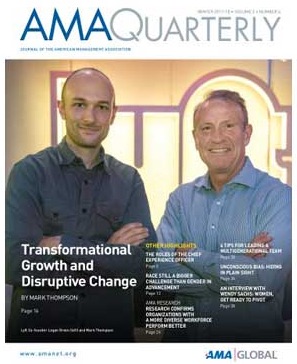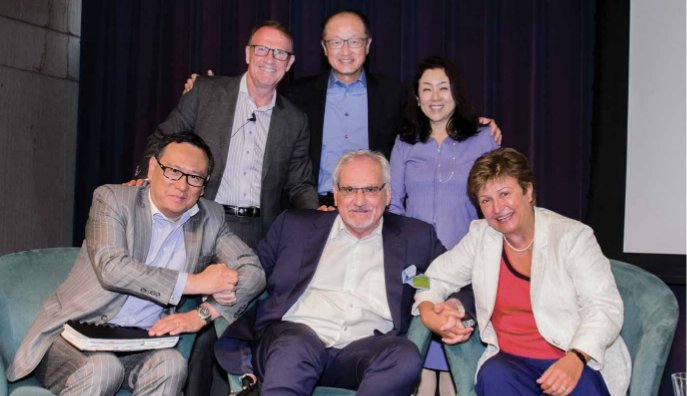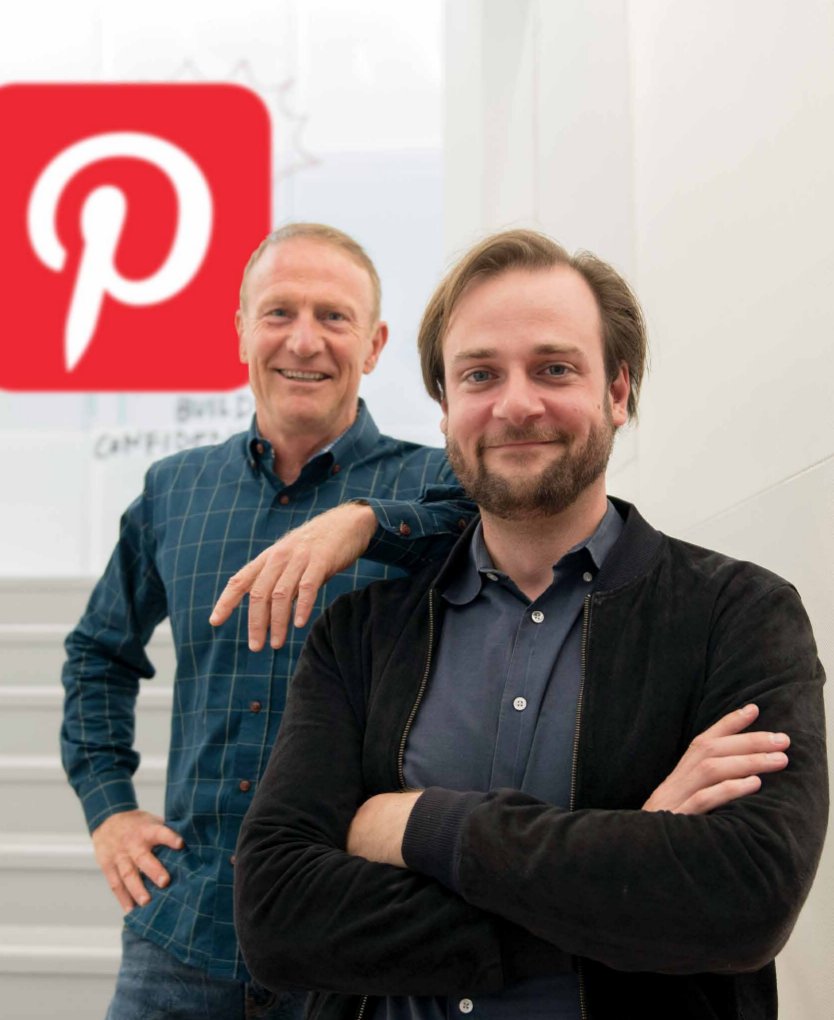Transformational Growth and DISRUPTIVE CHANGE
by Mark C. Thompson
How do world-class leaders accelerate growth and teamwork in times of disruptive change?

This season, more than five historic hurricanes ripped across thousands of miles of the northern hemisphere, setting new records for destruction. Millions of people were plunged into darkness, bracing for a deadly storm. In the wake of these storms, whole communities are struggling to rebuild both their personal lives and their businesses.
In some respects, we are all experiencing a version of this drama and trauma at the office every day, aren’t we? Do you know anyone who is not battling a series of sudden superstorms erupting in their industry or business? Is there anyone out there enjoying business as usual? The macroeconomic environment is serving up breathtaking disruptions with greater speed and such ferocious frequency that yesterday’s superstar leaders and global brands are quickly outpaced or overcome by more effective competitors. We’re all feeling the overwhelming pressure of change at work, whether we signed up for it or not.
Even one of the most powerful entrepreneurs in the world isn’t safe from disasters in nature and business. As Hurricane Irma tore through his family home on Necker Island in the British Virgin Islands, Virgin Group’s Sir Richard Branson and the remaining staff members on the island shivered in the basement. Deafening winds pummeled the walls like live ammunition, blowing out windows and doors and tossing buses and cottages like toys in The Wizard of Oz. This was not the first time disaster had struck his home. Just three years earlier, a single bolt of lightning incinerated his house. Now he was again taking refuge as yet another storm raged outside his newly rebuilt home in that very same location. And like most of his neighbors in the BVI and elsewhere in the Caribbean, Sir Richard would be starting over, again.
“If you’re complacent, resting on your laurels, thinking you’re somehow safe and above it all, disruption will come and get you!” Sir Richard says. “But this isn’t about blaming others, becoming mired in victimhood, or surrendering to difficult circumstances.”
Embracing growth in a chaotic environment takes resilience and persistence, and you can’t take the risk of standing still or ignoring what’s changing around you. As a leader in your own life and work, “you have to be the change you wish to see,” Sir Richard says, quoting Gandhi. “You can’t scale up a company faster than you’re willing to scale your own personal and professional growth.” You can’t transform your organization any faster than you’re willing to change yourself, Sir Richard believes. In a wild time where you’re expected to grow your business faster every quarter, “your job is to build a new you and engage a new us who’s better at what you do.”
Leaders Struggle to Define Success
In a global survey we conducted in 110 nations, we asked high achievers about their definition of success in this new world. Even the most accomplished leaders are feeling under siege to accommodate what seems like contradictory pressures to accelerate growth while lowering costs. They’re struggling to balance the dynamic needs of four generations of employees, clients, and stakeholders who themselves are now in a state of perpetual and unpredictable change driven by disruptive competitors, new technology, and shifting market demands.
Bestselling author Brian Tracy and I wrote a business leadership primer about how to manage in chaotic times in our book, Now, Build a Great Business!: 7 Ways to Maximize Your Profits in Any Market (AMACOM, 2010)
The trends we’ve seen in our research have become obvious in our coaching practice too. The greatest challenge for leaders today is activating their own willingness to continue to role-model change by demonstrating growth as individuals, and then engaging their people to drive change rather than be run over by it. Those who cling to the status quo, or who resort to defending past successes with complacency or denial, do so at their own risk. What we discovered in our research is that high achievers don’t have just one definition of success. Surprisingly we found three distinctly different ideals that collide as drivers of their behavior: Purpose—Performance—Passion. You will often hear these words being tossed around as synonymous, but our World Success Survey revealed that they are distinctively different but related concepts.
Purpose means that you’re pursuing a mission or ideal that’s larger than you as an individual; it could be a company, community, or other organizational ideal. Some people think of this as their legacy. Performance means that you’re driven to produce results and have impact for that Purpose—it’s something you care enough about to collaborate and even compete with others to win. In this context, Passion is about what drives your heart more than your head. It’s what you’d secretly do for free because it intrinsically motivates you. There are many things that you care about in life and work, but those things that ring all three of these definitions of success at the same time—Purpose, Performance, Passion—that triad is the formula for sustainable success.
The No. 1 priority for the highest achievers today is to lead a personal and professional transformation for themselves and their teams. But that lofty goal can feel like attempting to change tires in the middle of rush-hour traffic. You have to lead transformation without sacrificing financial and operating results, or injuring your engagement scores. So how exactly do you accomplish that? Here are four principles applied by some of the most successful (and most disruptive) leaders of the new world.
World Bank: Diversity and Inclusion as a Sustainable Competitive Advantage
As a physician, anthropologist, and Nobel laureate nominee, Jim Yong Kim was the first-ever non-financial executive to be appointed to lead the World Bank, which invests more than $700 billion in projects aimed at ending poverty around the globe. During his five years at the bank, Dr. Kim has led a painful reinvention of the institution, reducing bureaucracy and waste, that has resulted in a spectacular impact on programs: More than 1 billion fewer people now live below the poverty line.

“Jim Yong Kim was the first-ever non-financial executive to be appointed to lead the World Bank, which invests more than $700 billion in projects aimed at ending poverty around the globe.”
In just the last 30 days alone, the bank led over a dozen nations to raise $1.3 billion to support the largest women’s entrepreneurship funding program in history. During my three years coaching the leadership team, I’ve seen them change the world many times over, and the core asset driving their impact is their profound focus on diversity and inclusion. It’s not just a matter of fairness and humanity—which are obviously crucial—it’s an issue of brilliance.
Great leaders have to ask: Where does your innovation come from? Are you tapping into a diverse collection of views and backgrounds or just one homogenous group of people? How do you touch and engage a diverse workforce and diverse customers in every community you serve?
The World Bank does it by welcoming, encouraging, and harvesting the eclectic, exotic, and entrepreneurial ideas and insights of a choir of more than 80 nations that fund the bank. It’s not an imposition on management to hear out all these diverse ideas; it’s not a separate HR “program” to be tolerated.
It’s a core asset, and the bank sees it as a crucial sustainable competitive advantage. In fact, most countries send representatives to live right there onsite at the World Bank headquarters in Washington, D.C. Imagine working and living with people whose cultures are different and come from every corner of the planet, but whose voices each contribute to the largest brain trust of financial minds ever to assemble on the globe? Diversity is power! It’s the most natural source of differentiation from your competitors.
Virgin Group: Reinvent Your Assumptions, Burn the House Down
Sir Richard’s new home imploded, he had an epiphany about how to think about disruptive innovation that changed his life and work. He’s long been one of history’s greatest living entrepreneurial innovators, having launched more than 400 companies under the Virgin brand, touching almost every service business, from transportation to telecommunications, from health clubs to hotels. But his biggest insight about self-awareness and executive renewal in business came from losing his family home, the residence where he and his wife of three decades had raised their family (and now their grandchildren).
“Sir Richard has long been
one of history’s greatest living entrepreneurial innovators.
But his biggest insight about self-awareness and executive renewal in business came from losing his family home.“
Think about what it would be like if your dream house went up in flames. Stop reading this article right now and consider that possibility seriously. Your house burned down. Feel that for a moment.
OK, fortunately it didn’t really happen, but ask four important questions before the feeling wears off.
Would you:
- Rebuild your house exactly the same way, or would it be different?
- Recreate the same design, same architecture and space? Not likely.
- Restock it with all the same things? Probably not.
- Recruit all the same people to the project? If your organization vaporized, and your employees had all exited, would you work hard to invite certain people back to your organization? Who would that be? Would you not invite others back? If disaster struck, how would you decide what and who goes or stays? This can be a brutal and yet instructive set of lessons.
Why would you make all of the above choices?
For Sir Richard, seeing his dream turn to ashes was a teachable moment of epic proportions—an unexpected provocation to rethink innovation in a world full of surprises. With 400 management teams in the Virgin group clamoring for growth, he now coaches them to be absolutely sure they’re not just paving the old cow path unwittingly as they start construction or renovation. “Keep the best; lose
the rest! If you think you don’t have time to do this, then reimagine the inconvenience of having it all burn down. That would be a bigger bother!” he says.
Lyft: Values-Driven Leadership: Nobody Does it Alone
Another critical principle shared by growth- and change- oriented leaders is to explicitly select a shared set of values around your mission. How will you establish collaborative behaviors in the workplace to grow your team and your organization?
“Lyft [is] the world’s fastest-growing ride-sharing firm, whose focus on values-based service and collaborative leadership serves as ballast during this period of exponential growth and change.”
Lyft cofounder Logan Green was inspired to start his company after a trip to Africa, where he was awestruck to observe extraordinarily cooperative mass transit in Zimbabwe, despite the apparent chaos of a developing country. People would swarm toward their destinations loaded with chickens and produce, and Green was aghast to see how everyone who needed a ride was encouraged to get a lift from an agreeable driver, whether perched on the roof of an overloaded bus or precariously clinging to the back of a motorbike. The shared mission of helping each other get somewhere is intrinsic to the Zimbabwean culture, creating an unprecedented level of collaborative transit.
The experience inspired Green to start ZimCar, a name he chose in honor of the African country rather than his cofounder’s name, John Zimmer. Version 2.0 of that vision is a company called Lyft, the world’s fastest-growing ride- sharing firm, whose focus on values-based service and collaborative leadership serves as ballast during this period of exponential growth and change. Those values are part of the reason why Lyft is quickly overtaking Uber, whose ethical debacles tarnished a brand once destined to inherit world dominance.
Recognizing the value of Lyft’s focus on treating people better and building a sustainable technology platform, Green and Zimmer won billions of dollars of support from disruptive investors like Andreessen Horowitz, KKR, auto giant GM, and even Didi Kuaidi, Uber’s chief rival in China. As part
of a shared vision for safer, autonomous vehicles, Google is writing a big check to Lyft after having initially invested early on in Uber. (Today Google is suing Uber for stealing technology.)
The lesson here is that values matter more than at any other time in organizational development history. Values-driven principles are not an idealistic luxury or a marginal choice. Management must sponsor leadership programs that empower teams to engage in professional development that helps everyone—from the CEO to the frontline employee—to change and grow in ethical ways that anchor their company to a customer-focused mission in the face of ridiculously challenging business conditions.
Pinterest: Redefining Success

The fourth transformational principle embraced by the world’s growth-company leaders relates to how you measure and manage meaning in your life and work. Pinterest founders Evan Sharp and Ben Silbermann envisioned a world where every individual could discover and activate his or her passions online—the world’s biggest catalog of ideas to help you identify and actualize your desires.
Pinterest today engages more than 200 million users and this fall reached a pre-IPO market value of over $12 billion. If you haven’t paid the site a visit, it’s time that you give yourself permission to explore what success means to you, because that’s part of the secret formula that will help you generate sustainable success in a world characterized by dizzying change.
Disruptively successful people don’t settle on just one definition of success, but engage in a lifelong struggle to balance each of the three in their decision making, often describing it like juggling precious crystal balls while riding a unicycle. When you get them in sync, the result is something we all dream about in a world spinning with change: success thatmattersandlastsalifetime.
Mark Thompson is a New York Times bestselling leadership author and America’s No. 1 executive coach for growth companies. For a free copy of the World Success Survey, email Thompson at Mark@MarkCThompson.com
